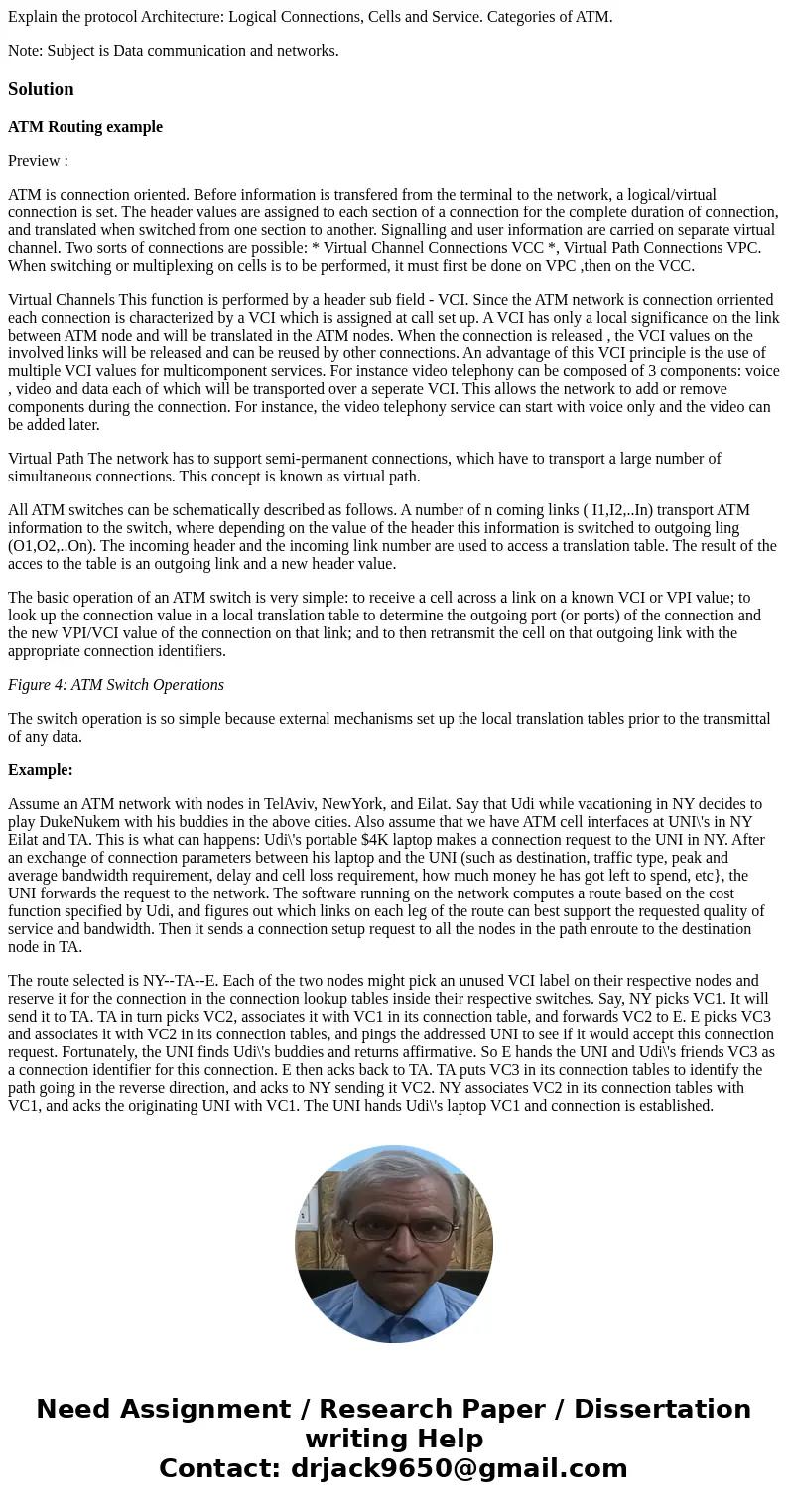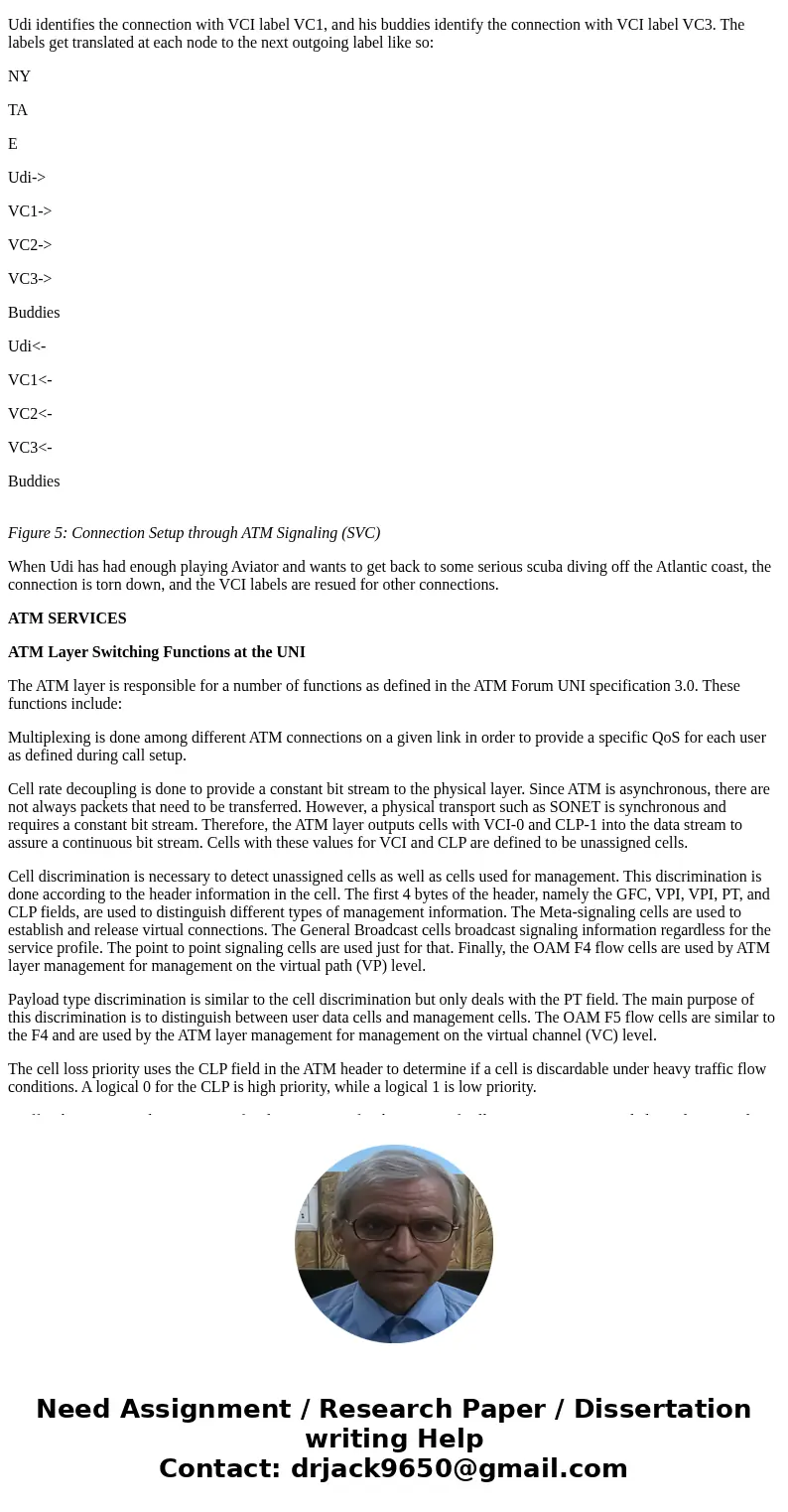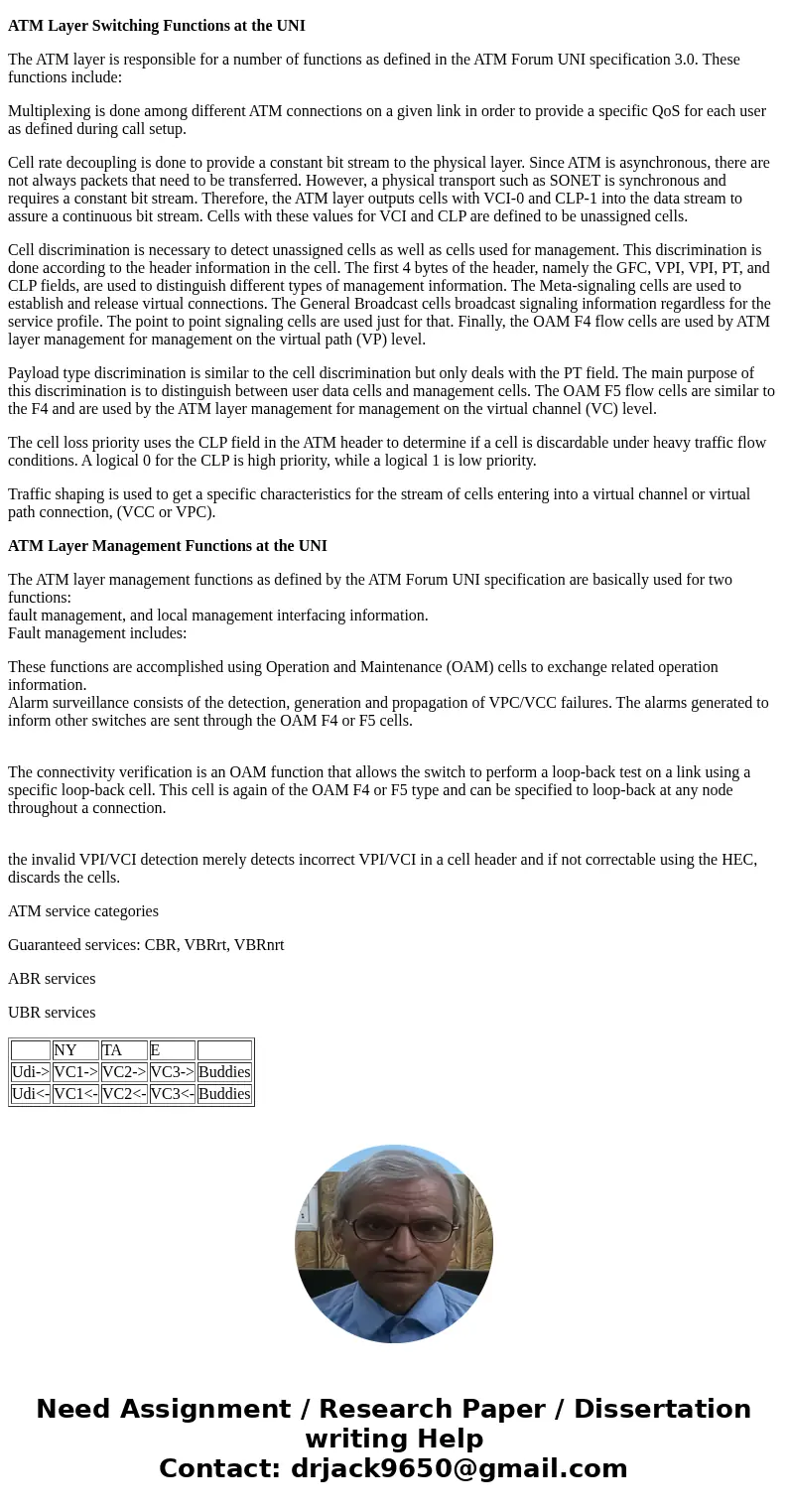Explain the protocol Architecture Logical Connections Cells
Explain the protocol Architecture: Logical Connections, Cells and Service. Categories of ATM.
Note: Subject is Data communication and networks.
Solution
ATM Routing example
Preview :
ATM is connection oriented. Before information is transfered from the terminal to the network, a logical/virtual connection is set. The header values are assigned to each section of a connection for the complete duration of connection, and translated when switched from one section to another. Signalling and user information are carried on separate virtual channel. Two sorts of connections are possible: * Virtual Channel Connections VCC *, Virtual Path Connections VPC. When switching or multiplexing on cells is to be performed, it must first be done on VPC ,then on the VCC.
Virtual Channels This function is performed by a header sub field - VCI. Since the ATM network is connection orriented each connection is characterized by a VCI which is assigned at call set up. A VCI has only a local significance on the link between ATM node and will be translated in the ATM nodes. When the connection is released , the VCI values on the involved links will be released and can be reused by other connections. An advantage of this VCI principle is the use of multiple VCI values for multicomponent services. For instance video telephony can be composed of 3 components: voice , video and data each of which will be transported over a seperate VCI. This allows the network to add or remove components during the connection. For instance, the video telephony service can start with voice only and the video can be added later.
Virtual Path The network has to support semi-permanent connections, which have to transport a large number of simultaneous connections. This concept is known as virtual path.
All ATM switches can be schematically described as follows. A number of n coming links ( I1,I2,..In) transport ATM information to the switch, where depending on the value of the header this information is switched to outgoing ling (O1,O2,..On). The incoming header and the incoming link number are used to access a translation table. The result of the acces to the table is an outgoing link and a new header value.
The basic operation of an ATM switch is very simple: to receive a cell across a link on a known VCI or VPI value; to look up the connection value in a local translation table to determine the outgoing port (or ports) of the connection and the new VPI/VCI value of the connection on that link; and to then retransmit the cell on that outgoing link with the appropriate connection identifiers.
Figure 4: ATM Switch Operations
The switch operation is so simple because external mechanisms set up the local translation tables prior to the transmittal of any data.
Example:
Assume an ATM network with nodes in TelAviv, NewYork, and Eilat. Say that Udi while vacationing in NY decides to play DukeNukem with his buddies in the above cities. Also assume that we have ATM cell interfaces at UNI\'s in NY Eilat and TA. This is what can happens: Udi\'s portable $4K laptop makes a connection request to the UNI in NY. After an exchange of connection parameters between his laptop and the UNI (such as destination, traffic type, peak and average bandwidth requirement, delay and cell loss requirement, how much money he has got left to spend, etc}, the UNI forwards the request to the network. The software running on the network computes a route based on the cost function specified by Udi, and figures out which links on each leg of the route can best support the requested quality of service and bandwidth. Then it sends a connection setup request to all the nodes in the path enroute to the destination node in TA.
The route selected is NY--TA--E. Each of the two nodes might pick an unused VCI label on their respective nodes and reserve it for the connection in the connection lookup tables inside their respective switches. Say, NY picks VC1. It will send it to TA. TA in turn picks VC2, associates it with VC1 in its connection table, and forwards VC2 to E. E picks VC3 and associates it with VC2 in its connection tables, and pings the addressed UNI to see if it would accept this connection request. Fortunately, the UNI finds Udi\'s buddies and returns affirmative. So E hands the UNI and Udi\'s friends VC3 as a connection identifier for this connection. E then acks back to TA. TA puts VC3 in its connection tables to identify the path going in the reverse direction, and acks to NY sending it VC2. NY associates VC2 in its connection tables with VC1, and acks the originating UNI with VC1. The UNI hands Udi\'s laptop VC1 and connection is established.
Udi identifies the connection with VCI label VC1, and his buddies identify the connection with VCI label VC3. The labels get translated at each node to the next outgoing label like so:
NY
TA
E
Udi->
VC1->
VC2->
VC3->
Buddies
Udi<-
VC1<-
VC2<-
VC3<-
Buddies
Figure 5: Connection Setup through ATM Signaling (SVC)
When Udi has had enough playing Aviator and wants to get back to some serious scuba diving off the Atlantic coast, the connection is torn down, and the VCI labels are resued for other connections.
ATM SERVICES
ATM Layer Switching Functions at the UNI
The ATM layer is responsible for a number of functions as defined in the ATM Forum UNI specification 3.0. These functions include:
Multiplexing is done among different ATM connections on a given link in order to provide a specific QoS for each user
as defined during call setup.
Cell rate decoupling is done to provide a constant bit stream to the physical layer. Since ATM is asynchronous, there are not always packets that need to be transferred. However, a physical transport such as SONET is synchronous and requires a constant bit stream. Therefore, the ATM layer outputs cells with VCI-0 and CLP-1 into the data stream to assure a continuous bit stream. Cells with these values for VCI and CLP are defined to be unassigned cells.
Cell discrimination is necessary to detect unassigned cells as well as cells used for management. This discrimination is done according to the header information in the cell. The first 4 bytes of the header, namely the GFC, VPI, VPI, PT, and CLP fields, are used to distinguish different types of management information. The Meta-signaling cells are used to establish and release virtual connections. The General Broadcast cells broadcast signaling information regardless for the service profile. The point to point signaling cells are used just for that. Finally, the OAM F4 flow cells are used by ATM layer management for management on the virtual path (VP) level.
Payload type discrimination is similar to the cell discrimination but only deals with the PT field. The main purpose of this discrimination is to distinguish between user data cells and management cells. The OAM F5 flow cells are similar to the F4 and are used by the ATM layer management for management on the virtual channel (VC) level.
The cell loss priority uses the CLP field in the ATM header to determine if a cell is discardable under heavy traffic flow conditions. A logical 0 for the CLP is high priority, while a logical 1 is low priority.
Traffic shaping is used to get a specific characteristics for the stream of cells entering into a virtual channel or virtual path connection, (VCC or VPC).
ATM Layer Management Functions at the UNI
The ATM layer management functions as defined by the ATM Forum UNI specification are basically used for two functions:
fault management, and local management interfacing information.
Fault management includes:
These functions are accomplished using Operation and Maintenance (OAM) cells to exchange related operation information.
Alarm surveillance consists of the detection, generation and propagation of VPC/VCC failures. The alarms generated to inform other switches are sent through the OAM F4 or F5 cells.
The connectivity verification is an OAM function that allows the switch to perform a loop-back test on a link using a specific loop-back cell. This cell is again of the OAM F4 or F5 type and can be specified to loop-back at any node throughout a connection.
the invalid VPI/VCI detection merely detects incorrect VPI/VCI in a cell header and if not correctable using the HEC, discards the cells.
ATM service categories
Guaranteed services: CBR, VBRrt, VBRnrt
ABR services
UBR services
| NY | TA | E | ||
| Udi-> | VC1-> | VC2-> | VC3-> | Buddies |
| Udi<- | VC1<- | VC2<- | VC3<- | Buddies |



 Homework Sourse
Homework Sourse